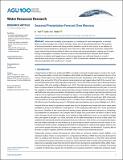| dc.contributor.author | Tuel, Alexandre | |
| dc.contributor.author | Eltahir, Elfatih A. B. | |
| dc.date.accessioned | 2020-05-26T18:58:37Z | |
| dc.date.available | 2020-05-26T18:58:37Z | |
| dc.date.issued | 2018-10 | |
| dc.date.submitted | 2018-03 | |
| dc.identifier.issn | 1944-7973 | |
| dc.identifier.uri | https://hdl.handle.net/1721.1/125460 | |
| dc.description.abstract | Interannual variability of precipitation is a challenge for water management in semiarid Morocco, where droughts are common and take a heavy toll on agricultural production. The question of forecast potential for winter and spring rainfall is therefore crucial for the country. As an addition to dynamical seasonal predictions, taking the case of the Oum Er Rbia watershed, the present study builds simple statistical forecasting models for Morocco's winter and spring precipitation, making use of oceanic forcing of atmospheric circulation. Previous results on the teleconnections between North Atlantic wintertime circulation and lagged ocean surface temperatures are confirmed. Based on a careful identification and selection of predictors, about 35–40% of interannual variability of precipitation may be robustly predictable with a lead time of 1 month. ©2018. American Geophysical Union. All Rights Reserved. | en_US |
| dc.description.sponsorship | Office Chérifien des Phosphates (OCP) through Université Mohamed VI Polytechnique. | en_US |
| dc.language.iso | en | |
| dc.publisher | American Geophysical Union (AGU) | en_US |
| dc.relation.isversionof | https://dx.doi.org/10.1029/2018WR022984 | en_US |
| dc.rights | Article is made available in accordance with the publisher's policy and may be subject to US copyright law. Please refer to the publisher's site for terms of use. | en_US |
| dc.source | MIT web domain | en_US |
| dc.title | Seasonal precipitation forecast over Morocco | en_US |
| dc.type | Article | en_US |
| dc.identifier.citation | Tuel, Alexandre and Elfatih A. B. Eltahir, "Seasonal Precipitation Forecast Over Morocco." Water Resources Research 54, 11 (November 2018): 9118-30 doi. 10.1029/2018WR022984 ©2018 Authors | en_US |
| dc.contributor.department | Parsons Laboratory for Environmental Science and Engineering (Massachusetts Institute of Technology) | en_US |
| dc.relation.journal | Water Resources Research | en_US |
| dc.eprint.version | Final published version | en_US |
| dc.type.uri | http://purl.org/eprint/type/JournalArticle | en_US |
| eprint.status | http://purl.org/eprint/status/PeerReviewed | en_US |
| dc.date.updated | 2020-05-22T16:37:29Z | |
| dspace.date.submission | 2020-05-22T16:37:32Z | |
| mit.journal.volume | 54 | en_US |
| mit.journal.issue | 11 | en_US |
| mit.license | PUBLISHER_POLICY | |
| mit.metadata.status | Complete | |
